
The Moon and Beyond
|
Since the beginning of time outer space has captivated mankind's imagination.
Astronomers for hundreds of years have stared into the evening sky analyzing and
mapping the stars and planets. Never before have we had the ability to actually propel
ourselves outside of Earth's atmosphere. Only now in the latter half of the 1900's, has
man been able to actual propel himself outside of Earth's atmosphere and explore for
himself outer space. Even now in the 1990's, space is as wide and vast as ever and is
truly the last great frontier. Just as the settlers headed west on the Oregon Trail in the
1860's, we head into outer space to conquer this great land beyond.
|
PAST:
|
The first manned space launch occurred in 1961, by a Russian Astronaut named
Yuri Alekseyevich Gagarin. His craft blasted into space, orbited the Earth once, and then
returned safely to land. This successful launch, orbit, and re-entry sparked the space race
that eventually landed a human on the moon. Even though this may mark the true
beginning of "The Space Race" many events had led up to this time.
|
|
Robert Goddard born in the late 1800's, is looked upon as the "Father of the Space
Age." Robert as a child often dreamed of one day designing a rocket that could propel
man into outer space. After obtaining his Ph.D. from Clark University, Robert went to
work designing rockets. One of his most famous experiments was that of whether or not
a rocket could operate in space. After building a large vacuum chamber and launching
more than 50 small rockets he concluded that rockets could indeed propel themselves
through space. In 1916, Robert concluded his work on solid fuels and began the
development of liquid propellants. By 1935, Robert's rocket was over 22 feet tall and
could climb to over 4,800 feet. Only ten years later Robert's health failed and he was laid
to rest August 14, 1945. Before his death he indicated his high hopes for the engineering
of rockets in the future. "I feel we are going to enter a new era, it is just a matter of
imagination how far we can go with rockets. I think it is fair to say you haven't seen
anything yet" (Goddard, Robert Hutchings).
|
|
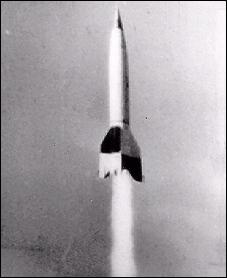 In Germany, a man by the name of Werhner von
Braun had been designing a new rocket, called
the V-2, that used liquid oxygen and alcohol as
propellants. With a range of 220 miles, a ceiling
of 55 miles, and a velocity of 3,500 mph this new
rocket was much more powerful than any of its
predecessors. The Germans launched the V-2 in
World War II at Holland and England. Von
Braun and his team of scientist were later arrested
by the Schutzstaffel (S.S.) and the Gestapo
because they had stopped designing military
rockets and had concentrated on rockets used for
space flight. Von Braun was later released and
escaped with his team of scientist to the U.S. In the U.S. Von Braun was allowed to
continue his research into rocket engines. With his help the army produced the Redstone
battlefield rocket and the Jupiter intermediate range ballistic missile. NASA (National
Aeronautics and Space Administration) on July 1, 1960, appointed Von Braun and his
team to form the core of the Marshall Space Flight Center. At Marshall he continued
development of even bigger rockets including: the Saturn I, Saturn IB and the Saturn V
rockets. These rockets would be of the same design of those that later landed a man on
the moon (Von Braun). In Germany, a man by the name of Werhner von
Braun had been designing a new rocket, called
the V-2, that used liquid oxygen and alcohol as
propellants. With a range of 220 miles, a ceiling
of 55 miles, and a velocity of 3,500 mph this new
rocket was much more powerful than any of its
predecessors. The Germans launched the V-2 in
World War II at Holland and England. Von
Braun and his team of scientist were later arrested
by the Schutzstaffel (S.S.) and the Gestapo
because they had stopped designing military
rockets and had concentrated on rockets used for
space flight. Von Braun was later released and
escaped with his team of scientist to the U.S. In the U.S. Von Braun was allowed to
continue his research into rocket engines. With his help the army produced the Redstone
battlefield rocket and the Jupiter intermediate range ballistic missile. NASA (National
Aeronautics and Space Administration) on July 1, 1960, appointed Von Braun and his
team to form the core of the Marshall Space Flight Center. At Marshall he continued
development of even bigger rockets including: the Saturn I, Saturn IB and the Saturn V
rockets. These rockets would be of the same design of those that later landed a man on
the moon (Von Braun).
|
|
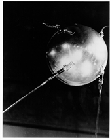 By the late 1950's, U.S.S.R (Russia) had launched several
space probes including the first man-made object to orbit the Earth.
This probe named Sputnik was launched on October 4, 1957. It was
a shiny basketball-size sphere that contained radio transmitters inside.
One month later the Soviet Union launched Sputnik 2 which was
larger and had a dog named Laika inside. Over the next three years
the Soviet Union launched six more of these Sputnik satellites each
one bigger than the one before. Each mission improved re-entry and recovery techniques
needed to launch a human into space. Building upon past knowledge and larger rockets
the U.S.S.R was able to in 1961, launch a Russian Cosmonaut named Yuri Alekseyevich
Gagarin into space. This achievement shocked the world and sparked the cold war race
between the U.S.S.R. and the U.S. that we are all so familiar with today (The Race
Begins). By the late 1950's, U.S.S.R (Russia) had launched several
space probes including the first man-made object to orbit the Earth.
This probe named Sputnik was launched on October 4, 1957. It was
a shiny basketball-size sphere that contained radio transmitters inside.
One month later the Soviet Union launched Sputnik 2 which was
larger and had a dog named Laika inside. Over the next three years
the Soviet Union launched six more of these Sputnik satellites each
one bigger than the one before. Each mission improved re-entry and recovery techniques
needed to launch a human into space. Building upon past knowledge and larger rockets
the U.S.S.R was able to in 1961, launch a Russian Cosmonaut named Yuri Alekseyevich
Gagarin into space. This achievement shocked the world and sparked the cold war race
between the U.S.S.R. and the U.S. that we are all so familiar with today (The Race
Begins).
|
|
By this time the United States realize, to their dismay, that they are far behind the
Soviet Union in space age technology. The U.S. called upon NASA, which was formed
on October 1, 1958, to replace the existing National Advisory Committee on Aeronautics,
to catch them up to the Russian's. With the support of the U.S. government NASA
launches a huge project with intentions of beating the Russian's to a manned moon
mission. The president, John F. Kennedy, announced that by 1969, America will have
placed a man on the moon. With those words NASA started off on the long road to the
moon.
|
|
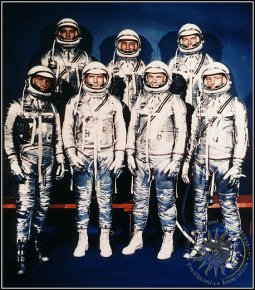 Mercury was the first of three
programs initiated by NASA to put a man on
the moon. Mercury had three objectives: orbit
a manned spacecraft around the Earth,
investigate man's ability to function in space,
and recover both man and spacecraft safely.
The program was initiated in 1958, and
completed five years later in 1963. In this five
year period more than 2,000,000 people
combine their resources to launch the 25
flights of the Mercury program. Through six
manned space flights it was demonstrated that
man could function for periods of up to 34
hours of weightless flight. The first man launched into space by the Mercury program
was John Glen in 1962, nearly a year after Russia had put the first man into orbit. The
spacecraft used for these space flights was a coned-shaped one-man capsule with a
cylinder mounted on top. Only 2 meters long and 1.9 meters in diameter the spacecraft
was barely spacious for a human occupant. What it lacked in size it made up for in speed.
The craft could reach 17,500 mph in a matter of seconds. 17,500 mph is called "escape
velocity" as it is the speed required to break through the Earth's atmosphere. By 1963,
the Mercury program had fulfilled all of its goals and was followed by an even more
successful program named Gemini (Mercury Archives). Mercury was the first of three
programs initiated by NASA to put a man on
the moon. Mercury had three objectives: orbit
a manned spacecraft around the Earth,
investigate man's ability to function in space,
and recover both man and spacecraft safely.
The program was initiated in 1958, and
completed five years later in 1963. In this five
year period more than 2,000,000 people
combine their resources to launch the 25
flights of the Mercury program. Through six
manned space flights it was demonstrated that
man could function for periods of up to 34
hours of weightless flight. The first man launched into space by the Mercury program
was John Glen in 1962, nearly a year after Russia had put the first man into orbit. The
spacecraft used for these space flights was a coned-shaped one-man capsule with a
cylinder mounted on top. Only 2 meters long and 1.9 meters in diameter the spacecraft
was barely spacious for a human occupant. What it lacked in size it made up for in speed.
The craft could reach 17,500 mph in a matter of seconds. 17,500 mph is called "escape
velocity" as it is the speed required to break through the Earth's atmosphere. By 1963,
the Mercury program had fulfilled all of its goals and was followed by an even more
successful program named Gemini (Mercury Archives).
|
|
As the Mercury program was coming to an end in 1963, the Soviet Union
achieved yet another first in the space race. On June 16, they launched Valentina
Vladmirovna Tereshkova, the first woman into space aboard VOSTOK 6. Her flight
lasted a little under 71 hours, in which she circled the Earth 48 times. After her flight she
went on to become involved with Soviet politics as chairman of the Soviet Women's
Committee, and the Chairman of the Cultural Exchange Federation (Valentina
Vladmirovna Tereshkova).
|
|
Gemini, the second program by NASA, was announced in January 1962. This
program was conceived after NASA officials realized that we needed an intermediate
step between Mercury and the Apollo Program. The Gemini was named after its two-man crew. Gemini completed a total of 12 flights, including two unmanned flight tests.
Gemini's objectives were very clear; make it possible for man and equipment to with
stand two weeks in space, to rendezvous and dock with vehicles while in orbit, and to
perfect entering the atmosphere and landing on preselected sites. All of these goals were
met, except the goal of making a land landing, which was canceled in 1964. The Gemini
spacecraft was basically a larger version of the Mercury capsule--5.8m long, 3m in
diameter, and about 8,400lbs. The Gemini program "retired" in November 1966 (Gemini
Project).
|
|
Apollo was unveiled by president John F. Kennedy in 1961. The Apollo
programs main intention was to land an American on the moon by 1969, before the
Russians. Secondary goals for the Apollo missions were to establish technology to meet
national interests in space; achieve dominance in space for the U.S.; and to perfect man's
ability to work in the lunar environment. The Apollo spacecraft was made up of three
parts: the command module(CM) which contained the crew's quarters and flight control
section, their service module(SM) for the propulsion and spacecraft support systems; and
the lunar module(LM), to take two of the crew to the surface, support them on the Moon,
and then return them to the CSM(command module and service module joined) in lunar
orbit. Project Apollo was no cheap program, it cost the U.S. taxpayers 25 billion
dollars.(Booth 9) Between the Apollo program and the Vietnam war our nations pockets
were nearly empty. Increased Inflation was a result of this, which upset the general
population, especially after the Apollo 1 disaster.
|
|
The Apollo 1 crew was conducting a simulation to see if the spacecraft would
function properly on internal power when the problems began. It was just after 6:30 p.m.
when the smoke alarm rang, ground crews saw a bright glow through the spacecraft's
window. White, Chaffee, and Grissom died in this fire on the launch pad. The fire was
caused by a spark from frayed wiring, fueled by pure oxygen, it caught a strip of velcro
on fire. The fire spread at an alarming rate consuming everything inside the oxygen rich
space craft. The crew was unable to unstrap themselves and open the escape latch before
the fire had produced enough toxic gases to prove fatal. This disaster shocked the nation
and led to a complete investigation of NASA and all of its independent contractors.
Although this catastrophe was huge officials believed that we must continue Apollo
missions if we wanted any chance of beating the Russian's to the moon.
|
|
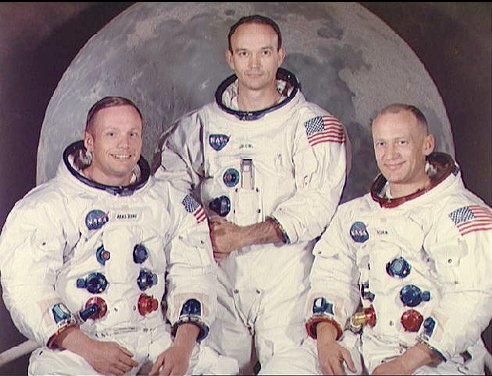 Finally after several manned missions to test the
feasibility of landing a man on the moon Apollo 11, named
COLUMBIA, was launched with intentions of landing the
first humans on the moon. The crew chosen for this mission
was: Neil Armstrong, Buzz Aldrin, and Michael Collins.
The crew of Apollo 11 had to prepare from January 9, when
they were named, until launch day and their lives had many
activities including: briefings on all the spacecraft systems, fittings for their spacesuits,
lessons in astronavigation and geology, rehearsal and simulations of procedures for
rendezvous, practicing lunar surface experiments, and whatever else their training officers
could fit into their hectic schedule. Apollo 11 lifted off on July 16, 1969, at 9:32 a.m.
Eastern daylight time, bound for the moon. At 4:18 p.m. four days later Neil Armstrong Finally after several manned missions to test the
feasibility of landing a man on the moon Apollo 11, named
COLUMBIA, was launched with intentions of landing the
first humans on the moon. The crew chosen for this mission
was: Neil Armstrong, Buzz Aldrin, and Michael Collins.
The crew of Apollo 11 had to prepare from January 9, when
they were named, until launch day and their lives had many
activities including: briefings on all the spacecraft systems, fittings for their spacesuits,
lessons in astronavigation and geology, rehearsal and simulations of procedures for
rendezvous, practicing lunar surface experiments, and whatever else their training officers
could fit into their hectic schedule. Apollo 11 lifted off on July 16, 1969, at 9:32 a.m.
Eastern daylight time, bound for the moon. At 4:18 p.m. four days later Neil Armstrong
 skillfully set the lunar module
EAGLE down in the "Sea of
Tranquillity." There they retrieved
samples of rock and took various
pictures of the Moon, themselves,
Earth, and other objects. Early in the
morning on July 24, 8 days, 3 hours,
18 minutes, and 18 seconds after
leaving the Kennedy Space Center,
COLUMBIA fell into the Pacific
Ocean approximately 200 nautical
miles south of Johnston Island.
This mission accomplished what 20
years ago nobody had dreamed of doing. It put the U.S. back in the running with the
Russian's for dominance of space. skillfully set the lunar module
EAGLE down in the "Sea of
Tranquillity." There they retrieved
samples of rock and took various
pictures of the Moon, themselves,
Earth, and other objects. Early in the
morning on July 24, 8 days, 3 hours,
18 minutes, and 18 seconds after
leaving the Kennedy Space Center,
COLUMBIA fell into the Pacific
Ocean approximately 200 nautical
miles south of Johnston Island.
This mission accomplished what 20
years ago nobody had dreamed of doing. It put the U.S. back in the running with the
Russian's for dominance of space.
|
|
One of the next extremely significant Apollo missions was Apollo 13. Apollo 13
was a following attempt at landing on the moon. Unfortunately problems occurred and
they were unable to land . The crew was made up of three men named: James A. Lovell,
Jr.(Commander), Fred W. Haise, Jr.(Lunar module pilot), and John L. Swigert,
Jr.(Command module pilot who replaced Ken Mattingly). Their mission objective was to
land in the Fra Mauro area of the Moon. Apollo 13 was launched April 11, 1970, at 1:13
p.m. CST, Saturday afternoon. Apollo 13 was unable to land because a service module
oxygen tank ruptured, and the command module's required supply of electricity, water,
and light was lost. Fortunately due to the quick thinking of the crew they were able to
use the moon's gravity as a sling-shot to propel themselves home. Apollo 13 arrived
home on April 17, 1970. They arrived on Earth earlier than planned but everyone was
just thankful that they got home. Apollo 17 was the last mission of the Apollo project. It
took off December 7, 1972, 12:33 a.m. and was manned by three men by the names of:
Cernan (Commander), Evans (Command Module Pilot), and Schmitt (Lunar Module
Pilot). While on the Moon they were to extend hardware capability, use a larger
scientific payload capacity and to try out and improve the usage of the battery powered
Lunar Roving Vehicle (LRV). Apollo 17 landed on Earth's surface December 19, 1972,
after completing its last mission (Apollo Project).
|
|
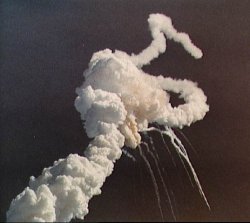 The space race has had its share of accidents: Apollo 1 and the loss of White,
Grissom, and Chaffee, Apollo 13 and the near loss of Lovell, Haise, and Swigert, and
then Challenger's tragic explosion. The Challenger Mission took off January 28, 1986,
with Scobee (Commander), Smith
(pilot), Resnik (Mission
Specialist1), Onizuka (Mission
Specialist 2), McNair (Mission
Specialist 3), Jarvis (Payload
Specialist 1), and McAuliffe
(Payload Specialist 2, a school
teacher). The whole world watched
in horror as the Challenger exploded
73 seconds after it lifted off. Later,
investigations indicated that a faulty The space race has had its share of accidents: Apollo 1 and the loss of White,
Grissom, and Chaffee, Apollo 13 and the near loss of Lovell, Haise, and Swigert, and
then Challenger's tragic explosion. The Challenger Mission took off January 28, 1986,
with Scobee (Commander), Smith
(pilot), Resnik (Mission
Specialist1), Onizuka (Mission
Specialist 2), McNair (Mission
Specialist 3), Jarvis (Payload
Specialist 1), and McAuliffe
(Payload Specialist 2, a school
teacher). The whole world watched
in horror as the Challenger exploded
73 seconds after it lifted off. Later,
investigations indicated that a faulty
|
|
O-ring on the booster rocket
sparked the explosion that
consumed Challenger. It took many years for NASA to regain its confidence in itself.
Challenger was a horrible tragedy that will hopefully never occur again.
|
PRESENT:
|
In the last decade, the space race has become more of a cooperative effort than a
race. With less one-upmanship going on between the United States and Russia, new
ideas and research have come to pass with the increased cooperation. Projects such as the
International Space Station are now possible. Still retaining independence from one
another, however, the United States has stepped forth with even more advanced missions.
|
|
 The International Space Station is the
largest cooperative scientific mission in history,
using the resources of sixteen countries: United
States, Canada, Belgium, Denmark, France,
Germany, Italy, Netherlands, Norway, Spain,
Sweden, Switzerland, United Kingdom, Japan,
Russia, Brazil. Among its many purposes are to
further medical research, create new partnerships
with other countries, and inspire the next
generation of scientists. The first element of the
space station, Zarya the Functional Cargo Block,
was launched in November, 1998, by Russian cosmonauts. In a total of 45 missions, the
space station is scheduled for completion in the year 2004 (International Space Station). The International Space Station is the
largest cooperative scientific mission in history,
using the resources of sixteen countries: United
States, Canada, Belgium, Denmark, France,
Germany, Italy, Netherlands, Norway, Spain,
Sweden, Switzerland, United Kingdom, Japan,
Russia, Brazil. Among its many purposes are to
further medical research, create new partnerships
with other countries, and inspire the next
generation of scientists. The first element of the
space station, Zarya the Functional Cargo Block,
was launched in November, 1998, by Russian cosmonauts. In a total of 45 missions, the
space station is scheduled for completion in the year 2004 (International Space Station).
|
|
 In April of 1990, the Hubble space
telescope was first launched by the space shuttle
Discovery to take its place as one of the biggest
events in aerospace research in the early nineties.
Its purpose was not to be the most powerful, but to
get beyond the earth's atmosphere to see a picture
of space more clearly than any other. Looking
through the earth's atmosphere is like looking
through a pool of water, it distorts the light. With
the advantages of the equipment aboard the
Hubble, scientists are able to learn more about solar systems of other stars, black holes,
and how galaxies are created (Hubble Space Telescope). In April of 1990, the Hubble space
telescope was first launched by the space shuttle
Discovery to take its place as one of the biggest
events in aerospace research in the early nineties.
Its purpose was not to be the most powerful, but to
get beyond the earth's atmosphere to see a picture
of space more clearly than any other. Looking
through the earth's atmosphere is like looking
through a pool of water, it distorts the light. With
the advantages of the equipment aboard the
Hubble, scientists are able to learn more about solar systems of other stars, black holes,
and how galaxies are created (Hubble Space Telescope).
|
|
The Galileo mission, launched in 1989, consists of two spacecraft: an
orbiter and an atmospheric probe. The two spacecraft are on a trajectory called
VEEGA (Venus-Earth-Earth Gravity Assist). What this trajectory does is gather
enough velocity from one pass by Venus and two passes by Earth to gain enough
speed to get to Jupiter. The main science goals for the Galileo Probe are: to
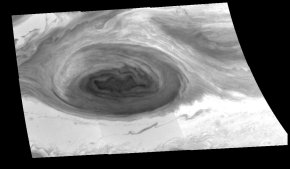 determine information about Jupiter's
atmosphere, examine Jupiter's radiative
heat balance, and study the nature of its
lightining activity. The Orbiter's goals
are to investigate the the atmosphere of
Jupiter and learn about the atmosphere's
and gravity of Jupiter's moons. The
Galileo mission will end on December
31, 1999. determine information about Jupiter's
atmosphere, examine Jupiter's radiative
heat balance, and study the nature of its
lightining activity. The Orbiter's goals
are to investigate the the atmosphere of
Jupiter and learn about the atmosphere's
and gravity of Jupiter's moons. The
Galileo mission will end on December
31, 1999.
|
|
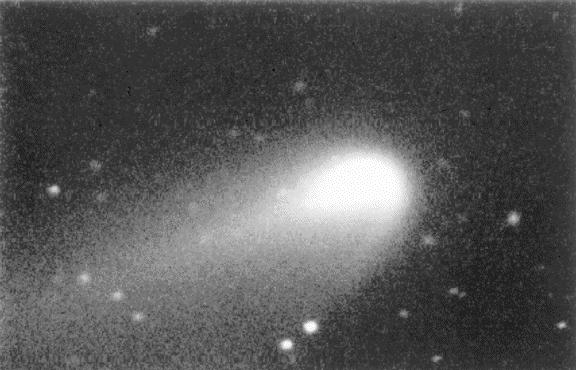 The Stardust mission, launched February 6th,
1999, is an attempt to bring back particles of the Wild-2 comet. The spacecraft will intercept the comet on
January 2nd, 2004, and begin collecting particles. The
craft will also collect dust particles entering our solar
system from the direction of the constellation
Sagittarius. The particles will be collected in a special glass gel called aerogel. The
collected samples will arrive back at earth in January, 2006. The Stardust mission, launched February 6th,
1999, is an attempt to bring back particles of the Wild-2 comet. The spacecraft will intercept the comet on
January 2nd, 2004, and begin collecting particles. The
craft will also collect dust particles entering our solar
system from the direction of the constellation
Sagittarius. The particles will be collected in a special glass gel called aerogel. The
collected samples will arrive back at earth in January, 2006.
|
|
Second only to the space station, and maybe not even that, the Mars missions
have been pushed forward more than any of the other missions of this decade. Mars
Pathfinder, Global Surveyor, and Polar Lander have become hot topics. The Pathfinder
mission placed a microrover vehicle on the surface of Mars to take in data and discover
more about the surface of Mars. The Global Surveyor was launched to return data about
the surface, atmosphere, and magnetic properties for use in planning future missions.
Mars Polar Lander will land on Mars in December, 1999, to take data from the polar
regions of the red planet. The already returned includes: maps, atmospheric conditions,
and climates of the red planet. The data collected in these missions and others is being
used to research a manned mission to Mars (Missions to Mars). Many more missions
can be expected in the near future to investigate our neighbor planet Mars.
|
FUTURE:
|
As of now we know of 16 moons that are orbiting around the planet Jupiter, but
one of these is a very special one. This moons name is Europa. Europa is like no other
moon in our entire solar system. It's surface is entirely covered with ice. What makes it
unique however is that beneath this layer of ice is liquid water. Europa is about 3138 km
in diameter. The ice covering is about 10-15 km thick which makes it five times more
reflective than our own moon and it is the smoothest object in our solar system. Europa
is small, very cold, and lacks an atmosphere. The surface of Europa looks cracked and
abused but this is kind of misleading. Remember that it's all ice. The water under the icy
surface is liquid because as the moon orbits Jupiter, the gravitational pull of the planet
bends and pulls on the little moon. When Europa is being squeezed its metallic core
gives off heat due to friction, therefore causing the ice to melt into water. We know that
on Earth organic life can be found in very cold water, such as under polar ice caps. This
leads to the theory that life may exist on the moon Europa. In the future The National
Aeronautics and Space Administration is planing a mission to the Jovian moon Europa.
The objectives of this mission would be to verify the presence of water, to measure the
thickness of the ice and find out interior properties, and to image surface features. The
mission would launch a probe to Jupiter which will pass Europa 10 times in a one year
period. Radar sounding would be used for finding the thickness of the ice and spectral
imaging would show surface features (Europa).
|
|
The space based defense system, popularly dubbed Star Wars, was a plan that was
started by President Reagan during the cold war. Star Wars is a development that would
eventually be a full defense mechanism that is totally in space. After the cold war
President George Bush officially called the project dead. Yet research has secretly
continued. Especially on a space based Laser configuration that would destroy enemy
missiles within seconds of launch. The lasers would be part of a Space Based Infrared
System (SBIS). In the future many things would be included in the system such as high
powered microwaves to take out enemy communications and a military spaceplane that
could arrive over trouble spots within 90 Minutes of launching. Right now though the
most probable and furthest along in technology is the Space-Based Laser. The laser is a
Hydrogen fluoride chemical laser capable of moving from one target to another in less
than a second. Because there is too much moisture in the atmosphere the laser can't reach
ground targets at this particular moment, but there may be something to reach the ground
in the future. Imagine a laser that could detect and destroy a missile that is 2,500 miles
away in just seconds (Star Wars).
|
|
Even though the achievments already made are great, mankind still has far to go
in its exploration of space. No matter how great of an acomplishment putting man on the
Moon was, its just the beginning of far greater achievements to come. Many people have
devoted their lives to the improvement of mankinds development and shall not be
forgotten. From the launch of Sputnik to the International Space Station being built, the
space race has come a long ways and definately isn't over yet.
Sources
|
|
Randall Gordon, Eric Mackie, J.D. Scott, Marrisa Dietz
|
|

